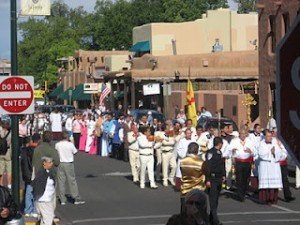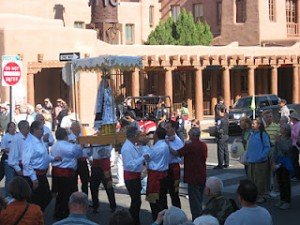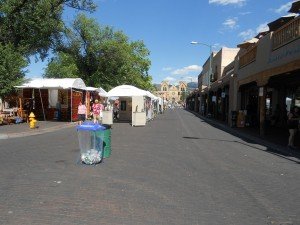One of the most enjoyable Santa Fe traditions I attend every year is the Santa Fe Fiesta. In Santa Fe, the Fiesta celebration is a big part of how Santa Fe came to be and it’s tradition goes all the way back to when the Spaniards settled the area of northern New Mexico in the 1600’s. If you’re planning a Santa Fe vacation I would recommend that you consider a visit to Fiesta Santa Fe. It makes a good addition to your New Mexico travel planner. The pictures of Santa Fe below show scenes from past Fiestas. Images of Fiesta guarantee an excellent photo opportunity especially around the Santa Fe plaza.
To fully understand Fiesta and why it is so significant to Santa Fe you have to look at the Pueblo Revoltwhich occurred in 1680. The annual Fiesta celebration commemorates Don Diego de Vargas‘ peaceful reoccupation of the City of Holy Faith in 1692. This was twelve years after the pueblo Indians drove the Spaniards out of New Mexico (Nuevo Mexico then) as a result of the very violent Pueblo Revolt.

The Spanish colonists fled to Guadalupe del Paso (Juarez Mexico today) and took with them from a burning mission the 29-inch wood carved Marian statue, La Conquistadora which was brought to Nuevo Mexico by the Franciscans in 1625. There were twelve years where the Spaniards, after retreating back down the Rio Grand to Mexico, were entirely absent from the area. There was a similar rebellion by Native Americans during the years 1634-38 which was called the Pequot War. The similarity was that it involved several Indian tribes banding together to fight the colonizers in New England. The difference of course was that they didn’t drive the British back across the Atlantic. The Indians were the ultimate losers in the Pequot War and didn’t regain many of their rights until centuries later.
The Pueblo Revolt itself is an interesting subject and there are several good books available on the topic. The main source of the pueblo Indian discontent with the Spaniards was due to a prohibition imposed on their traditional religion. The job of the friars who journeyed to the Nuevo Mexico was to convert the native population to Christianity. The hostility which was building up for decades also was caused by the Spaniards program of forced labor. The forced labor itself was bad enough but the effect it had on the pueblo economy also caused great problems. Much of the forced labor consisted of Indians having to erect Christian missions often timne at the same site where their sacred kivas were located. The causes of the Pueblo revolt of 1680 therefore involved both religious and economic reasons.
The Pueblo Revolt’s violence was such that the warring pueblo Indians killed twenty-one of the forty Franciscan friars and an additional three hundred and eighty Spaniards, including men, women, and children. Spanish settlers tried to flee to either Santa Fe or to the Isleta Pueblo which was one of the very few pueblos that did not join the rebellion. Most of the inhabitants of Isleta Pueblo, just south of Albuquerque fled to the Hopi area of Arizona or followed the Spaniards on their retreat southward along the Rio Grande.
During this twelve year period of Spanish retreat, the pueblo people inhabited Santa Fe. When you read about the history of this time you will see that the twelve year interval wasn’t necessarily peaceful. The basic problems that the now freed pueblos faced was fighting between themselves especially about which ones would occupy Santa Fe and there were attacks from outside nomadic tribes. The Spaniards themselves made a few raids into the area. Add to this a terrible drought and the local Indians had a pretty difficult time.

The combination of all of these hardships laid the foundation for the Spaniards “reconquest” of the province. In 1692 Diego de Vargas, returned to Santa Fe with a half dozen soldiers and several cannons, one Franciscan priest and a converted Zia Indian war captain. The group entered Santa Fe before dawn and called on the Indians. Diego de Vargas promised clemency and protection if they would swear allegiance to the Spanish King and again take up the Christian faith. The Indian leaders gathered in Santa Fe, met with Vargas and the Zian war captain and agreed to peace. It was a bloodless reconquest although there were some holdouts who didn’t necessarily agree with the new arrangement. This was probably expected and not unusual since there were many different tribes involved. The new Spanish rule proved to be quite different from the one prior to 1680. As an example, the Spanish issued land grants to each Pueblo and appointed a public defender to protect the rights of the Indians. The Indians also had access to the Spanish courts to decide on future disputes.

The Fiesta celebration commemorates this peaceful arrival of the Spaniards in Santa Fe under de Vargas and the acceptance by the pueblo residents. One of the key Fiesta elements is a procession which takes La Conquistadora from the Cathedral Basilica of Saint Francis to the Rosario Chapel at Rosario Cemetery in Santa Fe. This is a procession which you don’t want to miss when you attend Fiesta. At the end of Fiesta week the statue of La Conquistadora is then returned to the Basilica Saint Francis.
Two interesting and related articles we’ve published are the Indian Art Museum on Santa Fe’s Museum Hill and the Palace of the Governors on the Santa Fe Plaza.
In my opinion, one of the best books you can read with a great amount of detail about the Spanish rule of Nuevo Mexico and the Pueblo Revolt is The Pueblo Revolt of 1680: Conquest and Resistance in Seventeenth-Century New Mexico by author Andrew L. Knaut.
Another big event which is held in September after Fiesta is the Zozobra burning. Zozobra represents “old man gloom“. The burning of this 50 foot high marionette is a symbol of ridding oneself of the hardships and despair of the past year. After this event there is a commemoration ceremony of Diego de Vargas’ return to Santa Fe. Also included during Fiesta is a pet parade around the Santa Fe plaza and a Fiesta Ball.
(Photos from author’s private collection)

Comments are closed.